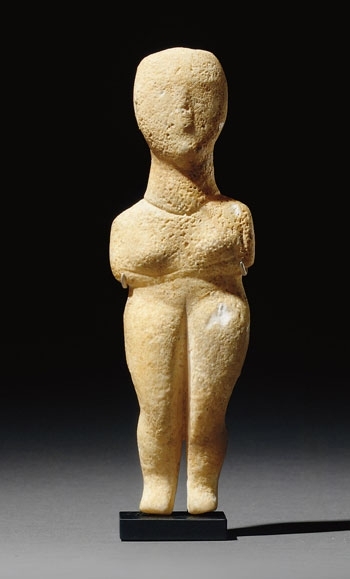College Museum Acquires Important Cycladic Figurine
For immediate release: 2/15/08
For further information contact: Pieter Broucke, Associate Curator of Ancient Art, broucke@middlebury.edu
Middlebury, VT—In Dec. the Middlebury College Museum of Art acquired at auction at Christie’s, New York, a rare Early Cycladic figurine. The small marble object, which depicts a nude female standing some five and one half inches tall, is thought to have been involved in rites surrounding death and burial.
During the Early Bronze Age (c. 3200–2200 B.C.E.), an island civilization flourished on the Cyclades, an archipelago in the Aegean. This Cycladic civilization had no writing system and presumably no permanent architecture, but its artwork contains clear evidence of seafaring and navigation. Most of the archaeological material for this civilization comes from cemeteries, and includes enigmatic figurines such as this one.
The standing nude female has a characteristic emphasis on the pubic triangle and breasts. The folded arms, summarily sketched by the Cycladic artist, simply run into each other. The legs, by contrast, are much more naturalistically rendered, a formal characteristic carried over from Late-Neolithic times.

The figurine belongs to a small group of so-called “pre-canonical” figurines created during a short transitional phase c. 2800–2700 B.C.E. Experimental in nature, they are the direct precursors to the well-known canonical “Folded Arm Figurines” typical of the Early Cycladic II Period (c. 2700–2200 B.C.E.).
Because they depict for the most part nude females, Cycladic figurines were long thought to be fertility charms of some sort. A recent study of the traces of paint on some of the figurines, however, has generated the more likely interpretation that the figurines represent mourners, a theory that is in line with their discovery in tombs.
Due to their abstract qualities and stark geometries, Cycladic figurines were highly esteemed throughout the twentieth century. They served as inspiration for such European artists as Jean Arp and Constantin Brancusi, and were eagerly collected by modern art connoisseurs worldwide.
Today, museums must scrutinize provenance, history of ownership, and authenticity each time they consider the acquisition of antiquities, given the pressing issues of illegal excavation and trade, and the many forgeries that swamp the art market. The Middlebury figurine came with documentation indicating that it was already in an American private collection in New York City prior to 1961, or well before 1972 when the UNESCO convention regulating the international trade of antiquities went into effect. Moreover, it is highly implausible that its is a clever forgery, given that the group of pre-canonical figurines was not recognized and established in the scholarship until the mid-1970s, some fifteen years after the figurine was first documented.
Middlebury’s Cycladic figurine now becomes the earliest figurative sculpture in the museum. As a representative work of art of such a brief but pivotal phase in Europe’s earliest Bronze Age culture, the figurine is an important addition to the museum’s holding of antiquities. It will shortly be on view in the ancient art gallery for the educational benefit and aesthetic pleasure of faculty, students, and the general public alike.
